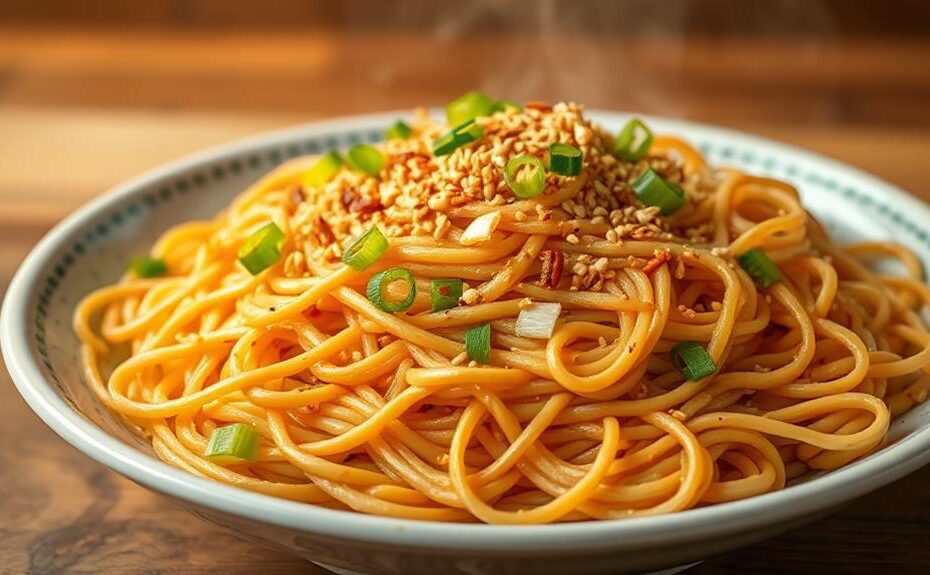Choosing the Right Noodles: Selecting the correct type of noodles is crucial for achieving the perfect plate of Pancit.
Rice vermicelli provides a light texture, while wheat egg noodles offer a chewy bite.
Balancing the Dish with Savory Sauce: A savory sauce is essential for a well-rounded Pancit dish.
Combine soy sauce and oyster sauce to create a balanced flavor profile.
Adding Protein for Flavor and Nutrition: Incorporating protein into your Pancit adds flavor and nutritional value.
Choose from chicken, pork, or shrimp to customize your dish.
Selecting and Cooking Vegetables: A variety of colorful vegetables adds visual appeal and texture to your Pancit.
Select vegetables such as carrots, cabbage, and bean sprouts, and cook them to crispy perfection to achieve the ideal texture.
By mastering these key components, you will be well on your way to crafting an authentic and delicious Pancit dish.
Essential Pancit Ingredients
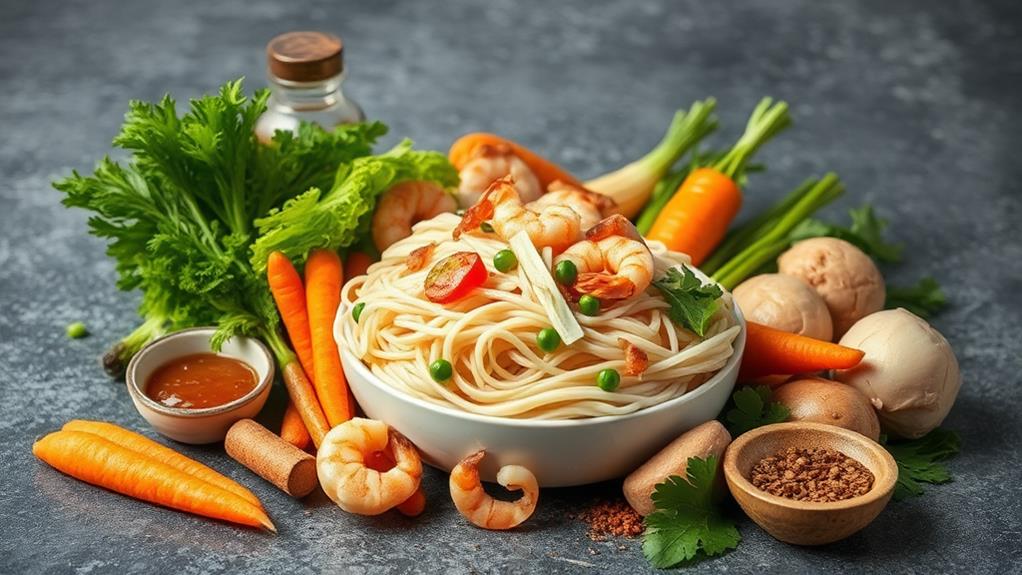
Choosing the Right Noodles
The type of noodles used in Pancit is crucial, and there are two options: rice vermicelli (bihon) and wheat egg noodles (canton).
Each type offers a distinct texture, allowing you to select the one that suits your preference.
Savory Sauces
Soy sauce and oyster sauce are essential for adding depth and a savory umami flavor to Pancit.
These sauces provide a rich and complex taste profile that enhances the overall dish.
Vibrant Vegetables
Cabbage, carrots, green beans, and onions are must-have vegetables in Pancit, providing color, texture, and nutrients.
You can adjust the quantities based on your personal taste preferences.
Protein Options
For a balanced meal, consider adding chicken, pork, shrimp, or tofu as protein sources in your Pancit.
These options cater to different tastes and dietary requirements.
Aromatic Foundation
A sautéed mixture of fresh garlic and onion serves as the aromatic foundation of Pancit, providing a flavorful base for the dish.
Mastering the Perfect Sauce
Mastering the Perfect Sauce
A well-balanced sauce is essential to elevate your Pancit from good to great. To achieve this, combine soy sauce and oyster sauce to create a rich, savory flavor profile.
Understanding the Flavor Components
| Flavor Component | Description |
|---|---|
| Umami | Soy sauce and oyster sauce for depth and richness |
| Aromatics | Minced garlic and diced onions for a flavorful base |
| Balance | Low-sodium soy sauce for controlled saltiness |
Building the Flavor Base
Incorporate aromatics like minced garlic and diced onions early in the cooking process to build a flavorful base for the sauce. Opt for low-sodium soy sauce to adjust the sauce's saltiness and allow for better control over overall seasoning without overpowering the dish.
Achieving Harmony
Consider adding a touch of sugar or a splash of vinegar to your sauce mixture to create a harmonious sweet and tangy balance that complements the savory elements. Allow the sauce to simmer briefly before combining it with the noodles and other ingredients, ensuring that the flavors meld beautifully.
The Result
Cooking Noodles to Perfection
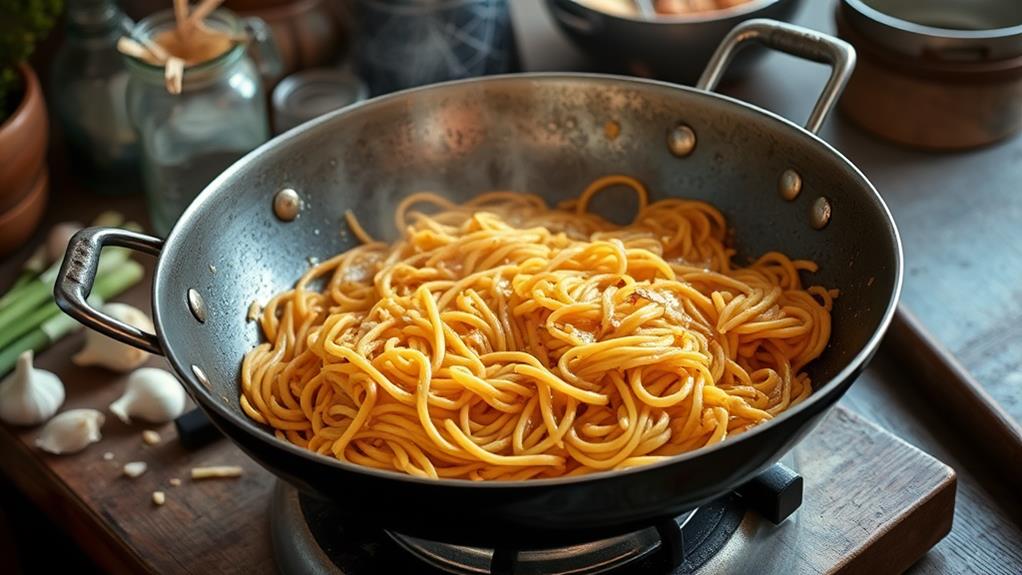
Cooking noodles to perfection is crucial to the success of Pancit.
To achieve this, soak rice noodles in warm water for 10-15 minutes to make them soft and pliable. This ensures even cooking when they're added to the stir-fry.
For egg noodles, boil them separately according to package instructions, typically 3-5 minutes, until they're al dente. This prevents them from becoming mushy when combined with other ingredients.
Drain the noodles well to avoid excess moisture, which can dilute the flavor of the dish.
When adding the noodles to the stir-fry, toss them gently in the pan to evenly distribute the sauce and prevent clumping.
If you prefer a firmer texture, fry the noodles for an additional minute after they're fully cooked to create a slightly crispy exterior.
Selecting the Right Vegetables
Selecting the Right Vegetables
Choose Fresh and Traditional Options
Select fresh vegetables like cabbage, carrots, and green beans, which are staples in traditional Pancit recipes. These provide optimal flavor and texture to your dish.
Cut your vegetables uniformly to ensure even cooking and a consistent texture.
Add Color and Nutrition
Incorporate bell peppers or snow peas to add colorful textures, enhance visual appeal, and boost nutritional value.
Consider using seasonal vegetables for added freshness and flavor. Options like zucchini or broccoli can be great additions depending on their availability.
Cooking Vegetables to Perfection
When sautéing your vegetables, cook them briefly to retain their crispness.
Avoid overcooking, which can lead to a mushy texture and detract from the overall quality of your dish.
Adding Protein for Flavor
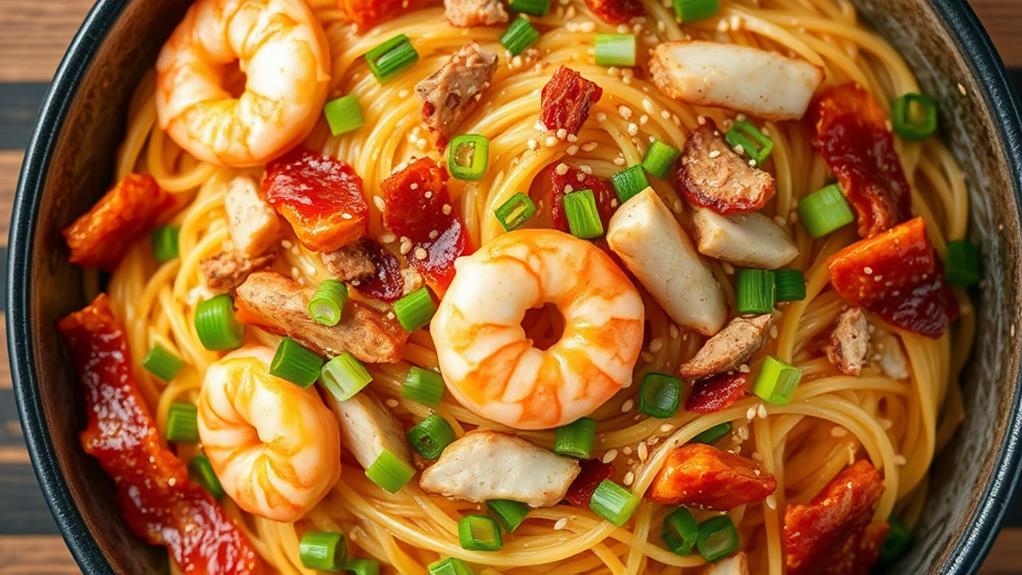
Adding Protein for Flavor and Nutrition
When preparing Pancit, incorporating protein is essential to elevate the dish's flavor and nutritional value. Protein not only enhances flavor but also provides a boost of nutrients, making Pancit a satisfying meal.
Choosing the Right Protein
When selecting protein, consider options that complement the dish's flavors and add nutritional value. Chicken, shrimp, or pork are excellent choices, with chicken providing around 26 grams of protein per 100 grams cooked.
To enhance flavor, marinate proteins in soy sauce and garlic for at least 30 minutes before cooking to infuse them with taste. Cook proteins separately in the skillet to achieve a golden-brown crust, adding depth to the overall flavor.
Consider using a mix of proteins, such as shrimp and pork, to create a more complex flavor profile and texture.
Incorporating Protein into the Dish
Once cooked, incorporate protein back into the dish towards the end of cooking to ensure it remains tender and juicy without overcooking. This achieves a harmonious balance of flavors and textures in the Pancit.
Balancing Flavors and Textures
Achieving Balance in Pancit
Harmonizing Key Elements
To create a perfectly balanced Pancit dish, five key elements must come together: protein, vegetables, noodles, seasonings, and texture. Balancing these components is crucial.
Savory Flavor Profile
Combine soy sauce and oyster sauce to create a savory flavor profile without overwhelming saltiness. This blend provides a rich, umami taste.
Texture and Nutrition
Incorporate a variety of vegetables, such as cabbage, carrots, and green beans, to add texture and nutritional value. These vegetables provide a satisfying crunch and boost the dish's nutritional profile.
Infusing Deep Flavors
When cooking proteins, marinate them in sesame oil, soy sauce, and garlic for at least 30 minutes to infuse deeper flavors before adding them to the stir-fry. This step enhances the protein's flavor and tenderness.
Textural Contrast
To create textural contrast, briefly fry the noodles at the end, allowing for a crunchy exterior and a soft interior. This step adds depth and interest to the dish.
Seasoning to Perfection
As you season your dish, adjust gradually, tasting as you go, to ensure each ingredient contributes to a harmonious final flavor. This step ensures the flavors are balanced and the dish is delicious.
Traditional Filipino Variations
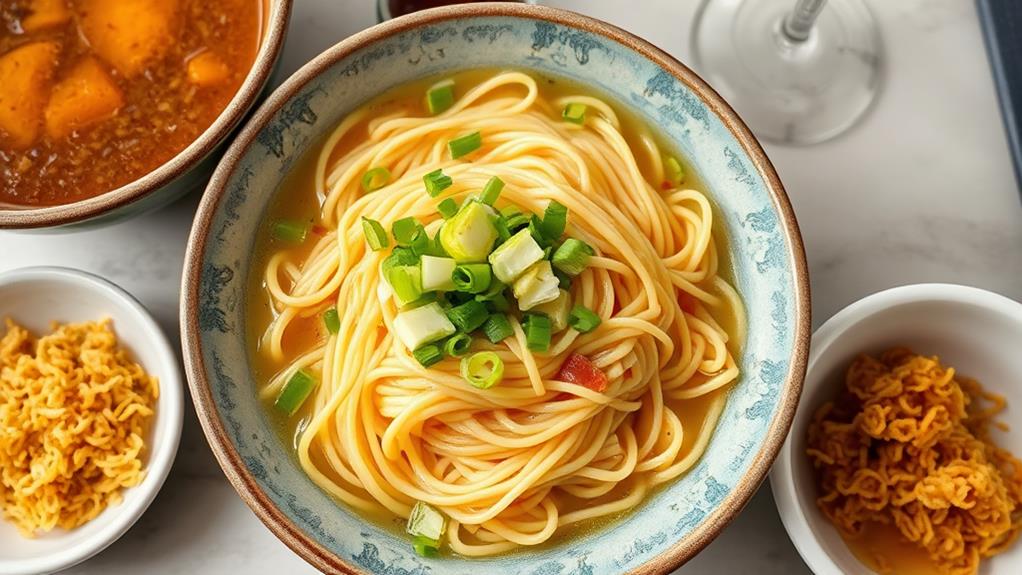
Traditional Filipino Variations of Pancit
Mastering the art of balancing flavors and textures in Pancit opens the door to exploring the rich diversity of traditional Filipino variations.
These variations showcase the versatility of this beloved noodle dish.
Traditional Filipino variations of Pancit offer a range of flavors and textures.
Four notable variations are:
- Pancit Bihon, made with rice vermicelli noodles, chicken or shrimp, and veggies, is a lighter option and a staple in many Filipino households.
- Pancit Canton features chewy egg noodles stir-fried with a mix of veggies and proteins, often resulting in a heartier dish perfect for gatherings.
- Pancit Malabon pairs thick rice noodles with a distinct shrimp sauce, often garnished with hard-boiled eggs and chicharrón (crispy pork skin).
- Pancit Palabok serves rice noodles with a vibrant orange shrimp-flavored sauce made from atsuete, commonly topped with shrimp and hard-boiled eggs.
These variations demonstrate the adaptability of Pancit, which has become a comfort food staple in many Asian recipes.
Modern Twists and Substitutions
Modernize Pancit with Healthier Noodles
You can refresh Pancit's traditional charm by using whole grain or vegetable-based noodles instead of traditional Pancit noodles. This substitution increases fiber and nutrient content in your dish. For example, try using whole wheat noodles or noodles made from vegetables like zucchini or sweet potatoes.
Gluten-Free Options
For a gluten-free version of Pancit, substitute rice noodles with spiralized vegetables like zucchini or sweet potatoes. This twist maintains the dish's essence while catering to gluten-free dietary needs.
Experiment with New Sauces
Try adding different sauces to your Pancit, such as teriyaki or sriracha, to cater to diverse taste preferences. These sauces add new flavor dimensions to the dish.
Vegetarian Options
To make a vegetarian version of Pancit, incorporate plant-based proteins like tofu or tempeh. This allows flexibility in accommodating dietary restrictions without sacrificing flavor.
Add Fresh Vegetables
Add seasonal vegetables like bell peppers, snap peas, or asparagus to give your Pancit a fresh and vibrant take. This enhances both the color and nutrition of the dish.
Common Mistakes to Avoid
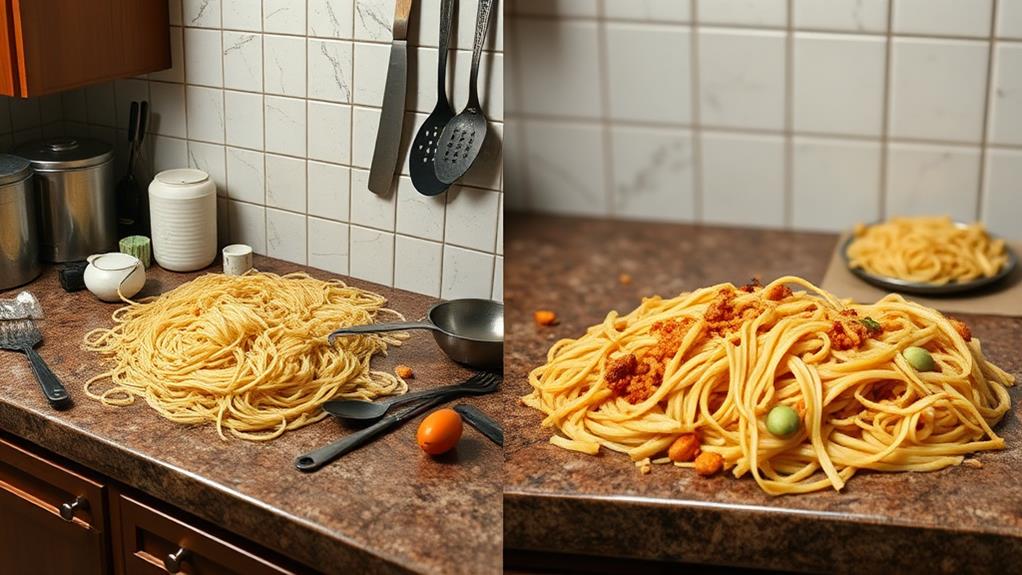
Common Mistakes to Avoid When Cooking Pancit
To create an authentic and delicious Pancit dish, it's crucial to avoid common mistakes that can ruin the texture, flavor, and overall quality of the dish.
Over-soaking Rice Noodles
Avoid soaking rice noodles for too long, as this can lead to a mushy texture. Instead, soak them just until they're pliable but still firm.
Uniform Vegetable Cutting
Cut all vegetables uniformly to ensure even cooking. This prevents some vegetables from becoming overcooked while others remain crunchy.
Gradual Liquid Incorporation
Add broth or sauces gradually to avoid sogginess in the final dish. Don't add too much liquid at once.
Seasoning Adjustment
Taste and adjust seasoning before serving to avoid a bland dish. Sampling and modifying flavors is crucial for a well-balanced taste.
Proper Pan Searing
Avoid crowding the pan when sautéing proteins and vegetables, as this can trap steam and prevent proper browning and flavor development.
What Are Some Expert Tips for Cooking Perfect Pancit Food at Home?
Cooking pancit food at home can be a delicious and satisfying experience. To ensure the perfect results, make sure to use high-quality fresh noodles and a flavorful broth. Don’t overcook the vegetables and meats, and add the ingredients in the right order to achieve a well-balanced flavor. Happy cooking pancit food at home!
Serving Suggestions and Garnishes
Elevate Your Pancit Presentation
Presentation Matters
The key to taking your Pancit to the next level lies in its presentation and accompaniments. Serving it with a side of lime or calamansi wedges will enhance the flavor and add a refreshing zest.
Chopped green onions or scallions as a garnish will add crunch and visual appeal.
Create a Well-Rounded Meal
Pairing your Pancit with lumpia (Filipino spring rolls) creates a well-rounded meal that combines textures and flavors.
Thinly sliced red bell peppers or carrots on top add a pop of color just before serving.
Add Extra Flavor and Aroma
Sesame oil or toasted sesame seeds on top of your Pancit add an extra layer of flavor and a nutty aroma.
These garnishes not only make your Pancit look appealing but also complement its flavors.
Frequently Asked Questions
How to Cook Pancit Canton Properly?
Mastering the Cooking of Pancit Canton
Step 1: Sauté Aromatics
To cook pancit canton properly, start by sautéing garlic and shallots in a hot wok. This brings out the flavors and aromas of the dish.
For example, heat 2 tablespoons of oil in a wok over medium-high heat, then add 3 cloves of minced garlic and 1 small minced shallot. Cook until they're translucent and fragrant.
Step 2: Customize with Flavor Combinations
Experiment with different flavor combinations to suit your taste.
For instance, add 1 tablespoon of oyster sauce to give the dish a savory flavor or substitute vegetables like carrots and cabbage with bok choy and mushrooms.
Step 3: Serve and Garnish
When serving, garnish with green onions and a squeeze of lime juice to add a burst of freshness to the dish.
This adds a pop of color and a touch of acidity to balance the flavors.
What Makes Pancit Unique?
Pancit's cultural significance makes it a unique dish. This Filipino staple is deeply rooted in the country's history and is often served during special occasions, such as birthdays and fiestas.
Its vibrant serving traditions vary across regions, with each area adding its own twist to the dish.
Adaptability is another key aspect of pancit's uniqueness. The dish can be made with various ingredients, such as rice flour, wheat flour, or even egg noodles, allowing it to be adapted to different tastes and dietary needs.
Regional variations also contribute to its distinctiveness, with different regions in the Philippines offering their own versions of pancit.
Balanced cooking techniques are used to prepare pancit, ensuring a perfect blend of texture and flavor. This approach also caters to health considerations, making pancit a nutritious option.
Pairing suggestions, such as serving it with a squeeze of calamansi (Filipino lime), add to its unique charm and flavor profile.
How Do You Keep Pancit Fresh?
Storing Leftover Pancit
To keep leftover pancit fresh, store it in airtight containers in the refrigerator, where it will last for 2-3 days.
When reheating, add a splash of water or broth to maintain the noodles' texture.
Freezing Pancit for Longer Storage
For longer storage, portion pancit into smaller servings and freeze them in freezer-safe containers.
To reheat, thaw overnight and reheat on low heat, stirring occasionally.
This way, you'll preserve the ingredient freshness and flavor, ensuring a delicious meal every time!
What Kind of Noodles Are Used in Pancit?
Two main types of noodles are traditionally used in pancit: bihon and canton. Bihon, also known as rice noodles, is light and gluten-free. Canton, on the other hand, is made from egg noodles and offers a chewier texture.
Other variations of noodles used in pancit include glass noodles, wheat noodles, and thicker lomi noodles, which are often used in different regional dishes. The choice of noodles affects the flavor profile, cooking method, and final presentation of the dish.
